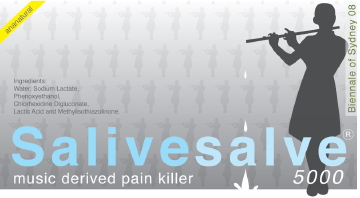
My biggest pet peeve in New York City is watching men (and women) of all walks of life, hack and cough, then swiftly discharge a slimy wad of saliva on the sidewalk as passersby narrowly attempt to avoid its path. Despite my repulsion for this most sordid act, saliva is the product of Ana Prvacki’s innovative performance at the Sydney Biennale this year in which she produced gallons of saliva through a solemn flute solo. The bodily fluid—known for its medicinal properties—is then used as a healing salve. Though her actual saliva cannot legally be used, Prvacki has worked with a chemist to create wet wipes infused with her music-derived painkiller that were distributed at her performance at Sydney’s Museum of Contemporary Art in June. The event was reviewed in the The Sydney Morning Herald and images of her performance can be seen on the 2008 Sydney Biennale website.
I’ve been thinking a lot about Prvacki’s performance in view of the upcoming exhibition, theanyspacewhatever, at the Guggenheim Museum, New York, organized by Chief Curator Nancy Spector, which will open this fall. The show addresses artists whose conceptual and social practices in the 1990s are frequently defined by the term “relational aesthetics,” a phrase coined by Nicolas Bourriaud in his collection of essays by the same name (originally published in France in 1998). Art: 21 artist Pierre Huyghe (Season 4) as well as Angela Bulloch, Maurizio Cattelan, Liam Gillick, Dominique Gonzalez-Forester, Douglas Gordon, Carsten Höller, Jorge Pardo, Philippe Parreno, and Rirkrit Tiravanija are included in the forthcoming exhibition. Though I am eager to see how this ambitious project is executed, I can’t help but question the institutionalization of such practices. Aren’t they inherently in opposition to such institutions? And where do artists like Lygia Clark, Jeremy Deller, William Pope L., and Ana Prvacki fit into this dialogue?



